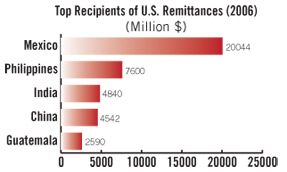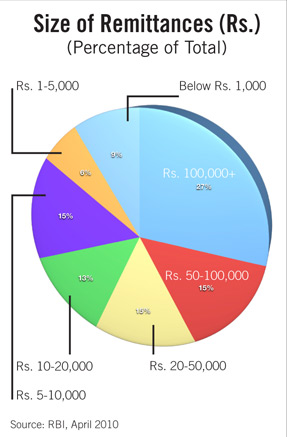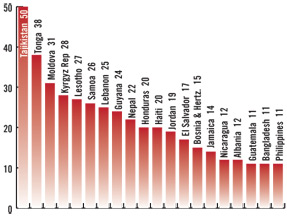|
Remember
the time you sent $100 to your favorite niece in Germany, or $800 to your sick
mother in India, or the $1,500 to your son for his exchange program in Paris?
The money you sent is part of the mega business of remittances, which in 2008
totaled $328 billion worldwide. The bulk of these remittances are transferred
by foreign workers to family members for household expenses in their home
countries. Remittances are the second largest financial inflow to many developing
nations after trade and are bigger than even international aid or total foreign
direct investment in India. For countries like Tajikstan, Tonga and Moldova,
remittances constitute between a third to a half of their gross domestic
product. They help fuel social and economic growth in many countries. Most
often expatriates use money transfer organizations (MTOs), such as Western
Union or MoneyGram, to send much-needed money to struggling family members back
home.
 |
The 25
million non resident Indians are among the largest migrant communities in the
world. Not surprisingly, India is the world’s largest recipient of remittances,
accounting for almost one in six dollars remitted worldwide. The $52 billion
remitted by overseas Indians to India in 2008 constituted nearly 4.2 percent of
India’s gross domestic product. Despite the recession, which analysts’ project
could see remittances decline by 6.1 percent in 2009, the World Bank estimates
that India received close to $49 billion in remittances last year.
One of the
reasons behind the massive surge of remittances to India is the burgeoning
Indian workforce in the Gulf countries. In addition, technical and professional
Indians in Europe, North America and Southeast Asia have become investment
savvy and are investing in Indian real estate and the stock market to take
advantage of the drop in prices and interest rates. Following the crackdown on
informal money transfer services after 9/11, Indians are forced to turn to
formal money transfer services and banks, instead of the informal exchanges of
friends and unlicensed cash agents, whose transactions are not recorded in
World Bank data. As a result of growing competition in this sector, transaction
costs for formal money transfers have dropped markedly in recent years. The
depreciation of the Indian Rupee by almost 25 percent against the U.S. dollar
during the last three quarters of 2008 also led to a surge in remittances.
 |
The burdensome
process of wire transfers and international money orders has been replaced by a
plethora of choices in recent years. Today one can use the internet and
electronic fund transfers (EFTs) to send money to anyone anywhere from home
using a bank account, credit or debit card or PayPal. Firewalls, background
checks on employees and encryption of personal information make these
transactions safe. Money transfer options include MTOs, such as Western Union
and MoneyGram, and banks, such as ICICI, CitiBank, State
Bank of India, Wells Fargo andHDFC. Xoom and Remit2India offer
internet focused services. Soon one may be able to transfer money using cell
phones.
Sujit
Kumar Varma, CEO, State Bank of India, New York, says, “The bulk of the inward
remittances are sent by individuals for the purpose of savings (as interest
rates are higher in India), family maintenance and the purchase of real
estate.” SBI is one of the largest retail bank players in the Indian market and
handles the largest volume of remittances within the banking sector. SBI only
handles remittances from its own customers or those registered with the bank,
but the average size of remittances handled by banks tend to be substantially
higher than those handled by MTOs, such as Western Union.
SBI’s U.S.
branches handled $450 million in individual remittances in 2008 and
approximately $320 million in 2009 to India. The volume of remittances has
slowed in the last two years, according to Varma, because of the downturn in
the economy. “In the latter part of 2009, the decline in volumes can also be
attributed to the appreciation of the Indian rupee against the U.S. dollar,
which resulted in people postponing their non essential remittances.”
While India is the
largest recipient of remittances, the United States is the leading source of
remittances. An estimated $47 billion in remittances were sent from America in
2008, according to the World Bank. This is more than twice that of any other
nation except Russia ($26 billion).Nearly half of
U.S. remittances ($25 billion) went to Mexico alone. According to Reserve Bank
of India data (see sidebar), nearly 29 percent of remittances to India come
from North America and 31 percent from the Middle East in 2009. This is a
marked reversal from 2007, when the proportion of remittances to India from
North America was greater than that from the Gulf. Thus, the recession marked a
shift in the geographic distribution of remittances.
 |
Remittances
to India remained surprisingly resilient during the global recession. A Reserve
Bank of India report in April 2010 reported that “inward remittances in India
have not been impacted significantly by the global economic crisis.” In fact,
notwithstanding the fiscal crisis in Dubai, where the construction sector was
hit hard, with devastating impact on migrant workers, especially from Kerala,
remittances were hardly dented. Many immigrants cut their own expenditures, by
sharing accommodation, for instance, so they could continue to send money home.
Western
Union, the world’s largest money-transfer company, continued to experience
robust growth in the India sector. Arti Kumar Caprihan, Vice President of
Product Management, U.S. Outbound to Europe, Middle East and South Asia, for
Western Union, says the primary reason clients remit money is to support
family, living expenses, gifts for birthdays or weddings, education and to buy
properties.
 |
“India
grew 11 percent in revenues and 22 percent in transactions in 2009. In the
Europe, Middle East, South Asia and Africa region, we saw a decline in revenue,
but a 10 percent growth in transactions in 2009 compared to 2008. However, in
the last quarter of 2009 it saw an increase of 6 percent in revenues and 8
percent in transactions. Business is healthy and has been increasing,” says
Caprihan. The rally is fuelled by remittances to rural areas in Punjab, Uttar
Pradesh, Kerala, Rajasthan, Maharashtra, Andhra Pradesh, Tamil Nadu and
Karnataka, which contribute 60 percent of Western Union’s India business.
Western
Union has aggressively courted South Asian consumers in the U.S. market for
years. “We are part of the Indian community and are experts in multi-cultural
marketing,” says Caprihan. The most active regions in India for Western Union
are Punjab, Gujarat and South India. In the United States, its largest NRI
customer base comes from California, New York and New Jersey.
Transaction
costs and exchange rates influence the costs of money transfer services (see
sidebar), but the ubiquity of agent locations give MTOs like Western Union and
MoneyGram a decided edge. Western Union, once best known for telegrams, is now
the world’s largest money transfer service with over $5 billion in annual
revenues. It has 410,000 agent locations and centers in 200 countries,
including 46,000 in the United States. In India, the company boasts over 50,000
agent locations and partners with 14,000 bank branches of the State Bank of
India, Bank of India and HDFC as well as 8,500 postal service locations.
MoneyGram, which is almost a fifth of Western Union’s size, claims 190,000
locations worldwide, nearly 22,000 of them in India.
MTOs have
the advantage of offering money transfer services all over the world. By
contrast, ICICI Bank presently allows remittances only to recipients in India.
Likewise, the internet money transfer service Xoom allows transfers to only
India in South Asia. But banks have the advantage of being the only ones
allowed to transfer outbound money from India. Remittance costs, which include
a base fee as well as foreign exchange rate margins, are typically lower with
banks than with money transfer services, but banks reserve the services for
their own or registered customers. MTOs are far more covenient to use and
speedier in remitting the money (see sidebar).
The Indian
money transfer market is highly fragmented with independent online companies,
large retail banks and money transfer services like Western Union and
MoneyGram. Reserve Bank of India data indicates that the market share of
remittance volume is 55-60 percent with banks, 35 percent with MTOs and 5-10
percent with online providers.
The MTO
space is dominated by two main players — Western Union and MoneyGram — and a
clutch of regional players who are prominent in certain money transfer
corridors. Nearly 60 percent of India’s population does not have bank accounts,
which gives companies like Western Union and MoneyGram a significant advantage.
Western Union caters to nearly 6.6 million customers in India and 60 percent of
its business in India comes from the rural sector. India and China combined
represented nearly 7 percent of Western Union’s 2009 revenues. Globally,
Western Union had a market share of about 16.9 percent in 2008 compared to 3.9
percent for MoneyGram.
 |
Because
banks handle larger ticket remittances, they have a larger share of the
remittance market by volume, even though MTOs have a larger proportion of
transactions. According to Ecommerce Journal, ICICI’s Money2India has a 20
percent market share of the bank remittance market in India, behind State Bank
of India, which is estimated to control a 24 percent share.
According
to SBI’s Varma: “Agencies like Western Union and MoneyGram handle remittances
on cash-to cash basis i.e. outside the banking channels. Such channels are
popular for sending small value remittances. SBI does not handle remittances on
cash basis and all our remittances are on account of our registered users and
account holders. Hence, we strictly follow ‘Know your customer’ (KYC)
guidelines.”
Although
the remittance sector has proven surprisingly resilient in the face of the
global recession, it continues to be beset by grave risks on multiple fronts.
There is still uncertainty about the economic health of countries around the
globe and the hiring of immigrants has declined in North America, Europe and
the Gulf. In the United States, for instance, thenumber of H1B visa applicants in 2009 fell to
46,700 against a 65,000 quota. By contrast, in 2007 and 2008 the quota was
exhausted within days of opening. A growing protectionist environment in the
United States is likely to result in thefurther tightening of immigration
laws. Many Indians have already returned to India as the Indian economy offers
them stronger prospects than the U.S. In addition, exchange rates, which proved
advantageous for expat Indians at the start of the economic crisis, are turning
as the dollar and the Euro are hammered. Finally, new technology could displace
traditional money transfer companies and disrupt the industry as a whole.
| Top 10 Recepients of Migrant Remittances 2009 (Billion Dollars) |
 |
| Top 10 Recepients of Migrant Remittances 2009 (Percentage of GDP) |
 |
|








